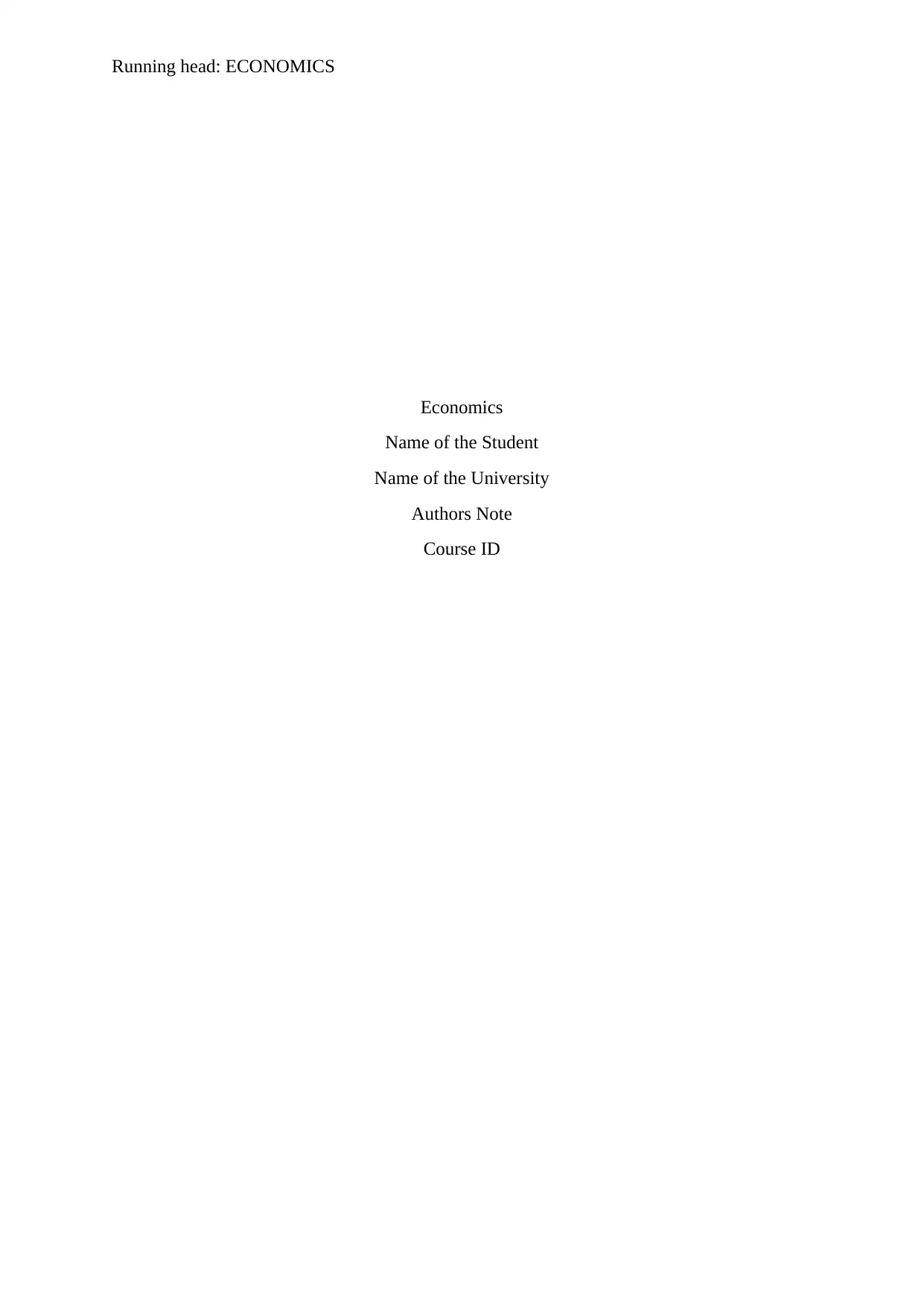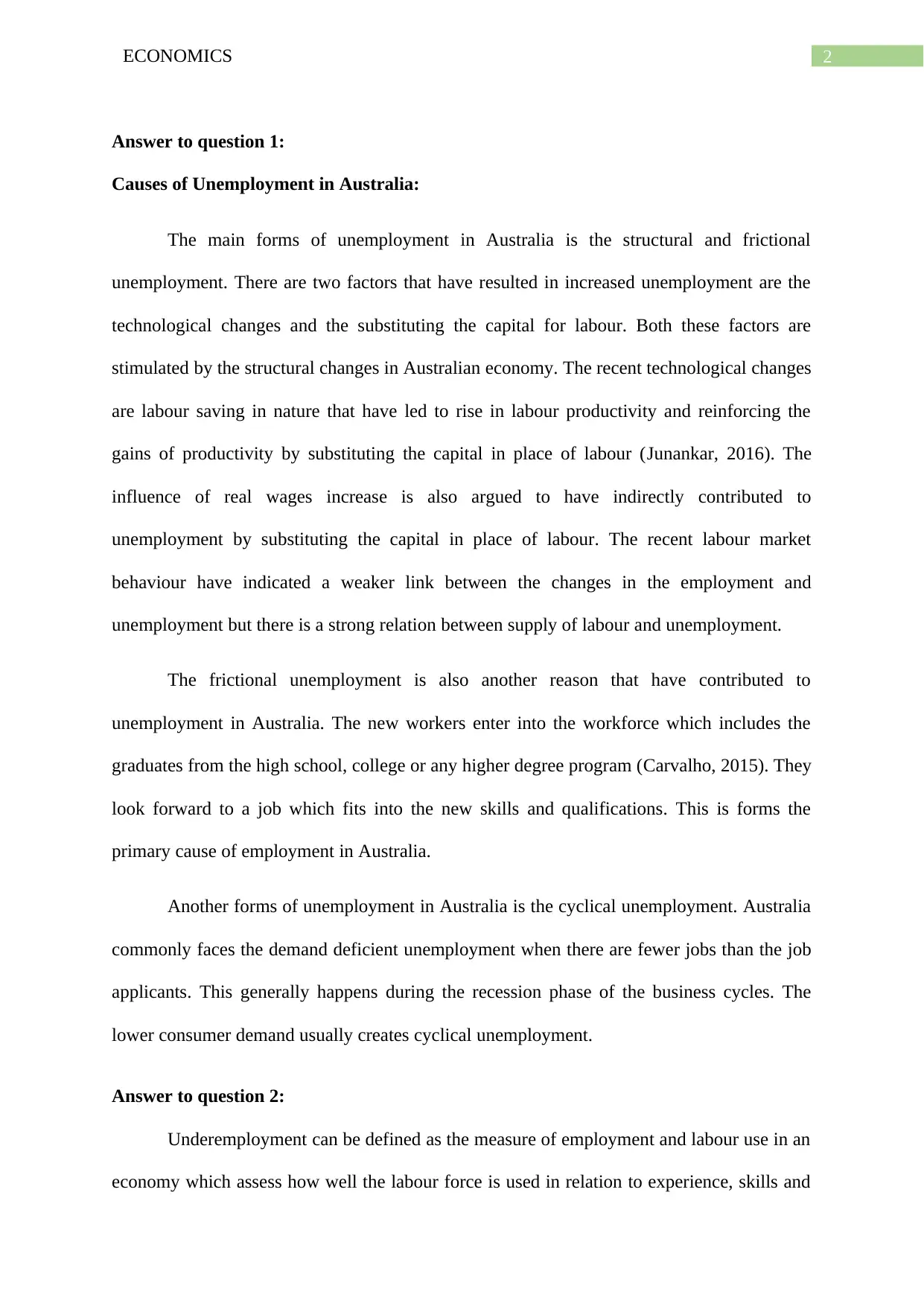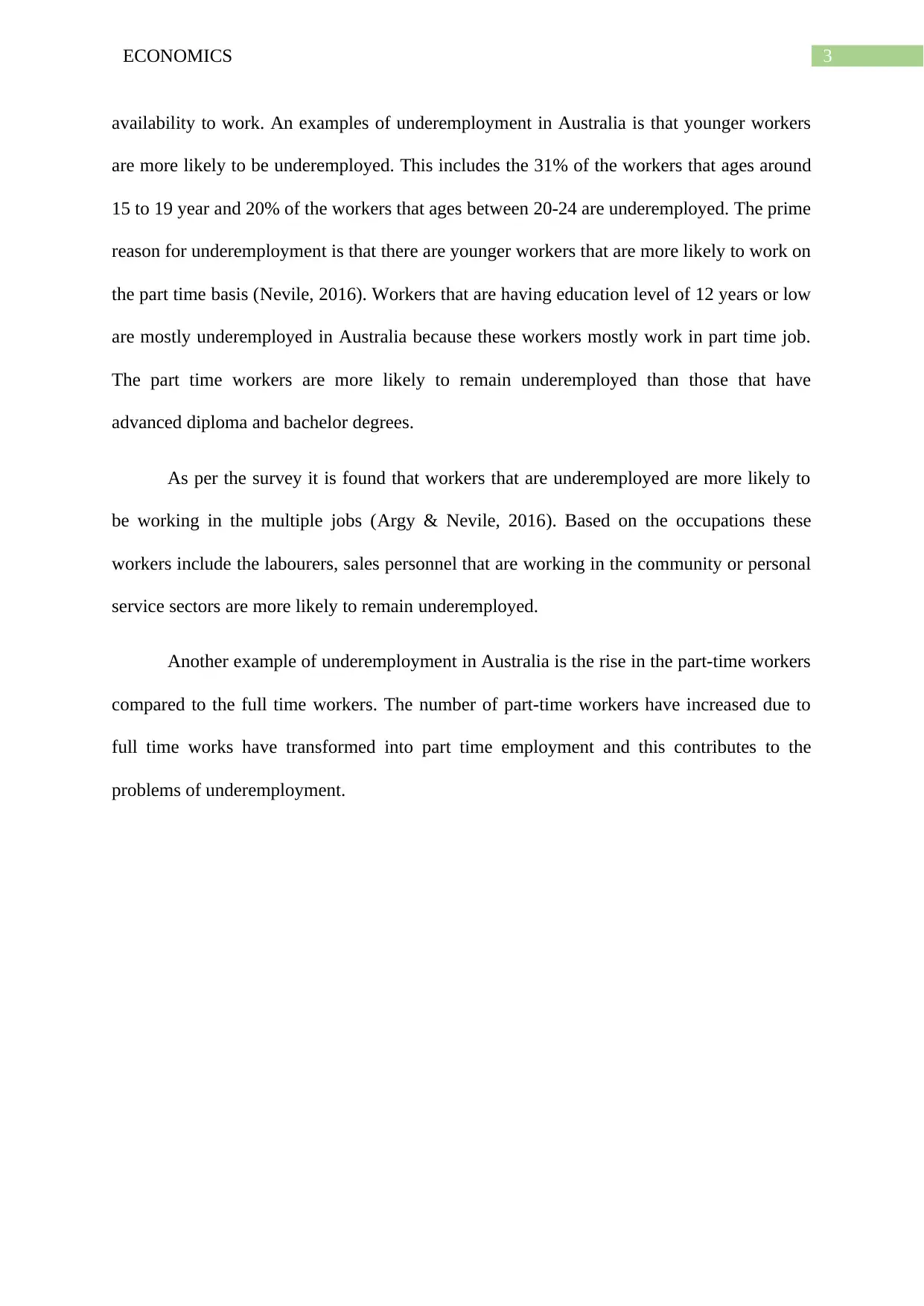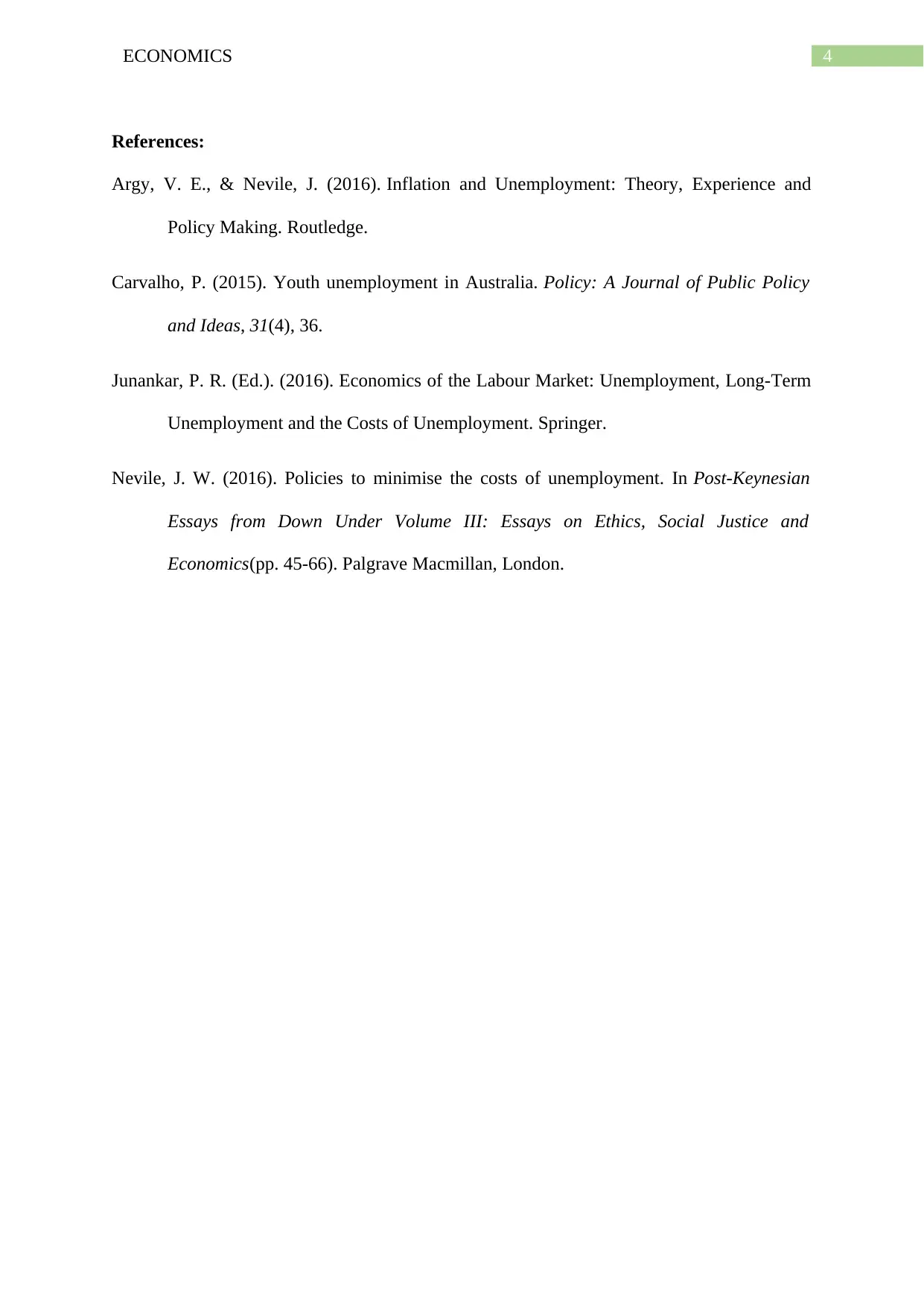Economics Assignment: Causes of Unemployment and Underemployment
VerifiedAdded on 2023/04/21
|5
|714
|282
Homework Assignment
AI Summary
This economics assignment delves into the causes of unemployment and underemployment in Australia. It identifies structural, frictional, and cyclical unemployment as key factors, examining how technological changes, real wages, and labor market dynamics contribute to unemployment. The assignment also explores underemployment, highlighting its prevalence among younger workers and those with lower education levels, and the rise in part-time employment. The solution provides examples of underemployment based on occupations and educational backgrounds, supported by references to relevant economic literature. The assignment aims to provide a comprehensive analysis of the Australian labor market challenges.

Running head: ECONOMICS
Economics
Name of the Student
Name of the University
Authors Note
Course ID
Economics
Name of the Student
Name of the University
Authors Note
Course ID
Paraphrase This Document
Need a fresh take? Get an instant paraphrase of this document with our AI Paraphraser

1ECONOMICS
Table of Contents
Answer to question 1:.................................................................................................................2
Answer to question 2:.................................................................................................................2
References:.................................................................................................................................4
Table of Contents
Answer to question 1:.................................................................................................................2
Answer to question 2:.................................................................................................................2
References:.................................................................................................................................4

2ECONOMICS
Answer to question 1:
Causes of Unemployment in Australia:
The main forms of unemployment in Australia is the structural and frictional
unemployment. There are two factors that have resulted in increased unemployment are the
technological changes and the substituting the capital for labour. Both these factors are
stimulated by the structural changes in Australian economy. The recent technological changes
are labour saving in nature that have led to rise in labour productivity and reinforcing the
gains of productivity by substituting the capital in place of labour (Junankar, 2016). The
influence of real wages increase is also argued to have indirectly contributed to
unemployment by substituting the capital in place of labour. The recent labour market
behaviour have indicated a weaker link between the changes in the employment and
unemployment but there is a strong relation between supply of labour and unemployment.
The frictional unemployment is also another reason that have contributed to
unemployment in Australia. The new workers enter into the workforce which includes the
graduates from the high school, college or any higher degree program (Carvalho, 2015). They
look forward to a job which fits into the new skills and qualifications. This is forms the
primary cause of employment in Australia.
Another forms of unemployment in Australia is the cyclical unemployment. Australia
commonly faces the demand deficient unemployment when there are fewer jobs than the job
applicants. This generally happens during the recession phase of the business cycles. The
lower consumer demand usually creates cyclical unemployment.
Answer to question 2:
Underemployment can be defined as the measure of employment and labour use in an
economy which assess how well the labour force is used in relation to experience, skills and
Answer to question 1:
Causes of Unemployment in Australia:
The main forms of unemployment in Australia is the structural and frictional
unemployment. There are two factors that have resulted in increased unemployment are the
technological changes and the substituting the capital for labour. Both these factors are
stimulated by the structural changes in Australian economy. The recent technological changes
are labour saving in nature that have led to rise in labour productivity and reinforcing the
gains of productivity by substituting the capital in place of labour (Junankar, 2016). The
influence of real wages increase is also argued to have indirectly contributed to
unemployment by substituting the capital in place of labour. The recent labour market
behaviour have indicated a weaker link between the changes in the employment and
unemployment but there is a strong relation between supply of labour and unemployment.
The frictional unemployment is also another reason that have contributed to
unemployment in Australia. The new workers enter into the workforce which includes the
graduates from the high school, college or any higher degree program (Carvalho, 2015). They
look forward to a job which fits into the new skills and qualifications. This is forms the
primary cause of employment in Australia.
Another forms of unemployment in Australia is the cyclical unemployment. Australia
commonly faces the demand deficient unemployment when there are fewer jobs than the job
applicants. This generally happens during the recession phase of the business cycles. The
lower consumer demand usually creates cyclical unemployment.
Answer to question 2:
Underemployment can be defined as the measure of employment and labour use in an
economy which assess how well the labour force is used in relation to experience, skills and
⊘ This is a preview!⊘
Do you want full access?
Subscribe today to unlock all pages.

Trusted by 1+ million students worldwide

3ECONOMICS
availability to work. An examples of underemployment in Australia is that younger workers
are more likely to be underemployed. This includes the 31% of the workers that ages around
15 to 19 year and 20% of the workers that ages between 20-24 are underemployed. The prime
reason for underemployment is that there are younger workers that are more likely to work on
the part time basis (Nevile, 2016). Workers that are having education level of 12 years or low
are mostly underemployed in Australia because these workers mostly work in part time job.
The part time workers are more likely to remain underemployed than those that have
advanced diploma and bachelor degrees.
As per the survey it is found that workers that are underemployed are more likely to
be working in the multiple jobs (Argy & Nevile, 2016). Based on the occupations these
workers include the labourers, sales personnel that are working in the community or personal
service sectors are more likely to remain underemployed.
Another example of underemployment in Australia is the rise in the part-time workers
compared to the full time workers. The number of part-time workers have increased due to
full time works have transformed into part time employment and this contributes to the
problems of underemployment.
availability to work. An examples of underemployment in Australia is that younger workers
are more likely to be underemployed. This includes the 31% of the workers that ages around
15 to 19 year and 20% of the workers that ages between 20-24 are underemployed. The prime
reason for underemployment is that there are younger workers that are more likely to work on
the part time basis (Nevile, 2016). Workers that are having education level of 12 years or low
are mostly underemployed in Australia because these workers mostly work in part time job.
The part time workers are more likely to remain underemployed than those that have
advanced diploma and bachelor degrees.
As per the survey it is found that workers that are underemployed are more likely to
be working in the multiple jobs (Argy & Nevile, 2016). Based on the occupations these
workers include the labourers, sales personnel that are working in the community or personal
service sectors are more likely to remain underemployed.
Another example of underemployment in Australia is the rise in the part-time workers
compared to the full time workers. The number of part-time workers have increased due to
full time works have transformed into part time employment and this contributes to the
problems of underemployment.
Paraphrase This Document
Need a fresh take? Get an instant paraphrase of this document with our AI Paraphraser

4ECONOMICS
References:
Argy, V. E., & Nevile, J. (2016). Inflation and Unemployment: Theory, Experience and
Policy Making. Routledge.
Carvalho, P. (2015). Youth unemployment in Australia. Policy: A Journal of Public Policy
and Ideas, 31(4), 36.
Junankar, P. R. (Ed.). (2016). Economics of the Labour Market: Unemployment, Long-Term
Unemployment and the Costs of Unemployment. Springer.
Nevile, J. W. (2016). Policies to minimise the costs of unemployment. In Post-Keynesian
Essays from Down Under Volume III: Essays on Ethics, Social Justice and
Economics(pp. 45-66). Palgrave Macmillan, London.
References:
Argy, V. E., & Nevile, J. (2016). Inflation and Unemployment: Theory, Experience and
Policy Making. Routledge.
Carvalho, P. (2015). Youth unemployment in Australia. Policy: A Journal of Public Policy
and Ideas, 31(4), 36.
Junankar, P. R. (Ed.). (2016). Economics of the Labour Market: Unemployment, Long-Term
Unemployment and the Costs of Unemployment. Springer.
Nevile, J. W. (2016). Policies to minimise the costs of unemployment. In Post-Keynesian
Essays from Down Under Volume III: Essays on Ethics, Social Justice and
Economics(pp. 45-66). Palgrave Macmillan, London.
1 out of 5
Related Documents
Your All-in-One AI-Powered Toolkit for Academic Success.
+13062052269
info@desklib.com
Available 24*7 on WhatsApp / Email
![[object Object]](/_next/static/media/star-bottom.7253800d.svg)
Unlock your academic potential
Copyright © 2020–2025 A2Z Services. All Rights Reserved. Developed and managed by ZUCOL.





